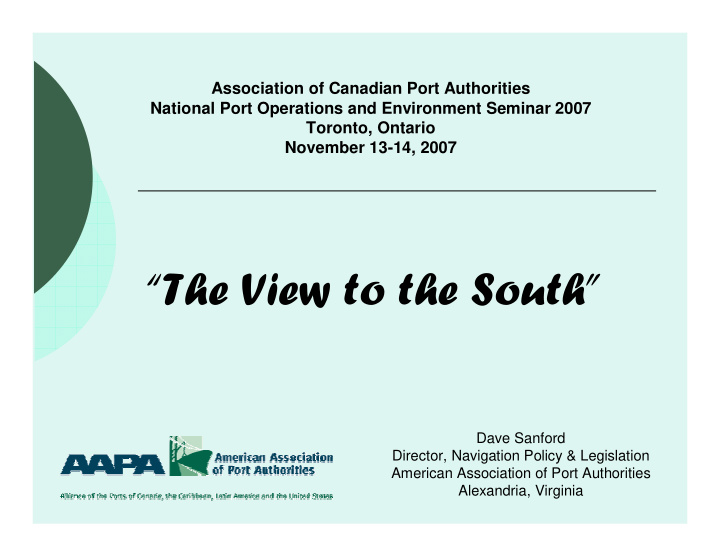



Association of Canadian Port Authorities National Port Operations and Environment Seminar 2007 Toronto, Ontario November 13-14, 2007 “The View to the South” Dave Sanford Director, Navigation Policy & Legislation American Association of Port Authorities Alexandria, Virginia
Operational Best Practices • Chassis Pools • Congestion Mitigation
Chassis Problem • Ports are facing congestion and terminal space issues in the face of exponential growth • With each steamship line using proprietary chassis, the following challenges are presented: – the number of chassis required takes up valuable terminal space – the need to constantly reposition chassis causes congestion – the speed, efficiency, and safety of the interchange of containers are reduced by this complexity
Enter Chassis Pools All lines in a port area or region contribute assets to a pool of chassis which is managed and maintained by a third party – all chassis available for use by pool participants – Chassis sorting by steamship line is not required – Separate inventories are not required – Single source for chassis management and coordination – Substantial reduction in footprint dedicated to storing chassis on terminal – Improvement from 60% to 80% utilization would reduce the number of bare chassis sitting idle on terminal – Less repositioning = Less congestion
Congestion Mitigation Many AAPA member ports are dealing with congestion at critical levels both within their terminals and immediately outside of their gates along connecting highway and rail infrastructure • Extended Gate Hours – Opening gates beyond the traditional 8 AM – 5 PM timeframe – encourage off-peak terminal visits and reduce traffic on congested roadways – Charleston and Oakland have seen success here • Peak Pricing Incentive Programs (PIERPASS) – LA-Long Beach – Traffic Mitigation Fee assessed for peak hour gate moves – Fees are waived for truck moves during non-peak hours and for rail moves – Use peak-hour fee to shift truck traffic to new off-peak hours 6 pm to 3 am Monday-Friday – 35% of daily container traffic now moves in off-peak hours • Reduce Free Dwell Time on Terminal – Customers will pick up the box if they are being charged storage
Port Safety Best Practices • Developing a Positive Safety Culture in the Port Environment • Terminal Traffic Safety
Developing a Positive Safety Culture in Port Environment • Port Safety Policy Statement with senior staff support and signatories • Safety Audits & Inspections • Regular Safety Meetings & Trainings • Outreach programs (signage, themes, recognition programs, newsletters, etc…) • Accident Rate Monitoring and Trending
Terminal Traffic Safety • The majority of work-related injuries and fatalities occurring in marine terminals are caused by traffic accidents • More projected cargo + increasing velocity requirements = more traffic accidents on terminals
Terminal Traffic Safety • Internal review of potential concerns • Concentrate on high traffic areas • Perform traffic engineering studies and recommendations • Install appropriate traffic controls and signage • Involve all internal stakeholders in solutions (Safety, Operations, Engineering, Maintenance, Risk Management, Police, etc.) • Universal enforcement of traffic safety regulations across the port area • Long term planning
IT Enhancing Operations • Gate Innovations and Technologies for Improving Throughput, Efficiency and Security • Improving Port Efficiency: Processes, Simulations and Modeling for Better Terminal Operations and Planning • RFID: Improving Supply Chain Visibility and Security
Gate Innovations • Appointment systems – Web-based data entry completed ahead of gate move – generates appointment with time window for gate transaction • Automating identification processes for trucks, containers and chassis with technology portals – RFID tags – Optical Character Recognition (OCR) – GPS • Informs the Terminal Operating System and yard management tasks for “inside the gate” efficiency
Processes, Simulations and Modeling • Virtual Container Yard – Street interchanges enabled by web portals tracking container locations and availability – Importers send empties to exporters locally – return to the port loaded – reduces congestion due to repositioning empties and storage at terminals • Using simulation software to model terminal operations scenarios – Assists with infrastructure and capacity planning – Examples at Port of Tacoma in intermodal • Intermodal Yard Capacity Planning System (IYCAPS) • Agile Port System
RFID: Visibility and Security • Radio Frequency IDentification – Tags are attached to equipment – Tag ID linked to equipment ID – Transmit data to readers as they pass • As part of a real time location system provides instant location/status/information – Can be used at the gate and on terminal to track assets and cargo – Can be used beyond the gate as a supply chain visibility tool – One example model: SAVI Networks • Deploying an RFID network in major ports to provide global visibility of cargo containers • Shippers pay for RFID tags and RFID infrastructure at supply chain end points • Terminal benefits: Audit trail and change of custody, Automated Track & Trace, Automated Seal Validation - recording of sealing and unsealing events Complements other technology projects (Asset management, chassis tracking, OCR, etc.)
Port Security Impacts on Port Operations • Radiation Portal Monitors: Design and Implementation Issues – Allocating the required footprint on terminal – Integrating their use into gate and/or quayside operations – tailoring the procedures for their use to the volume of the terminal operation • Credentialing Maritime Workers and its Impact on Goods Movement and Operations – Making Facility Security Plan adjustments to minimize impacts on goods movement – Anticipating technology needs and infrastructure for biometric readers and access control points – Security procedures and resource requirements for ineligible or non-vetted visitors/workers (e.g. escorting requirements in or through secure and restricted areas )
Recommend
More recommend